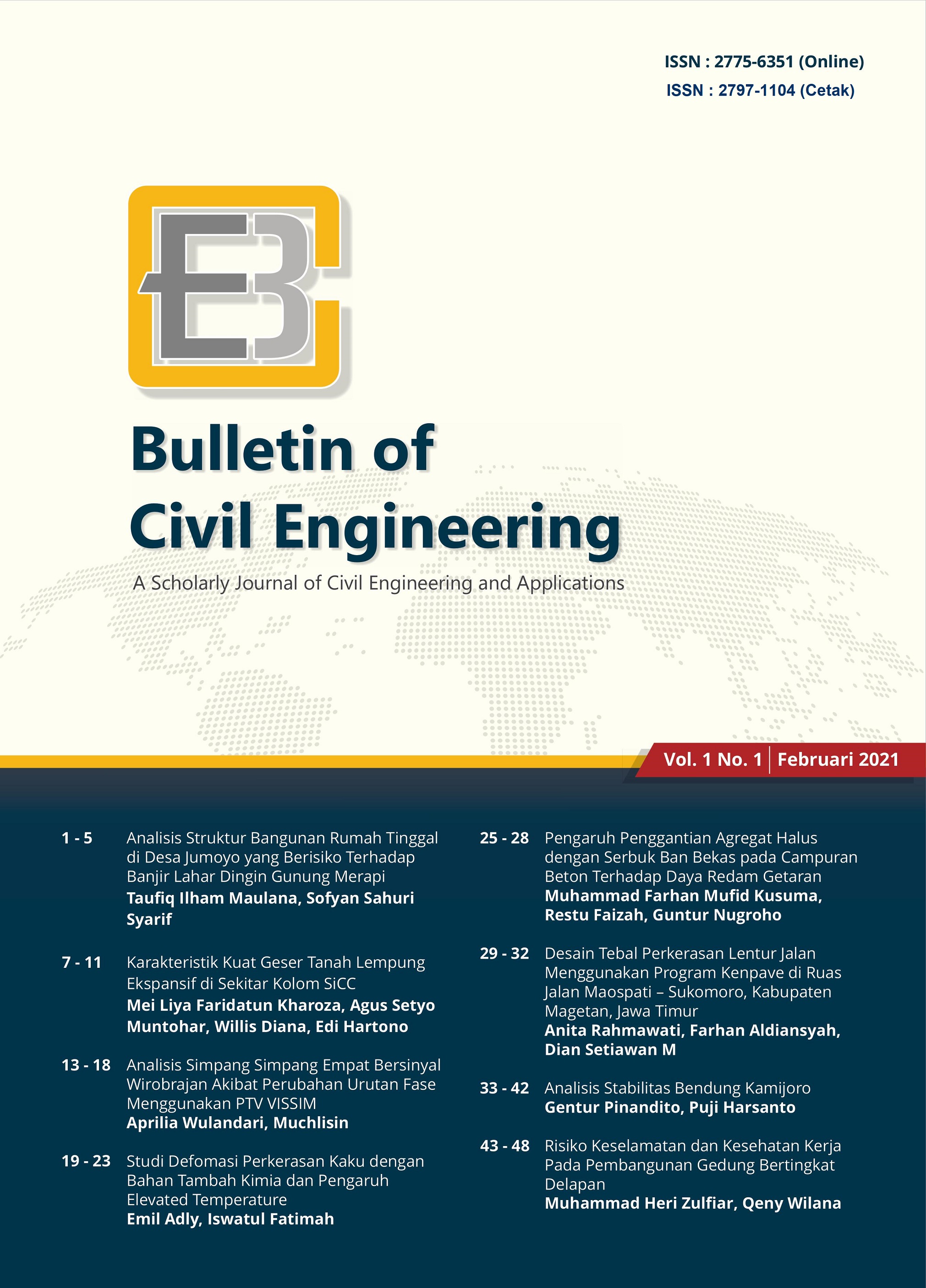Analisis Stabilitas Bendung Kamijoro
DOI:
https://doi.org/10.18196/bce.v1i1.11098Keywords:
Stabilitas bendung, metode jaringan aliran, rembesan, erosi bawah tanahAbstract
Bendung Kamijoro direncanakan untuk suplesi air di Bendung Pijenan yang mengairi daerah irigasi seluas 2.370 ha, yang terdiri atas daerah irigasi Jigutan seluas 296 ha dan Kebonongan seluas 2.074 ha. Selain dapat menyalurkan irigasi secara optimal, bendung juga harus memenuhi persyaratan stabilitas. Penelitian ini bertujuan untuk mengetahui nilai faktor aman Bendung Kamijoro terhadap gelincir, guling, maupun pipping yang mana merupakan persyaratan utama dalam menentukan apakah bendung dapat dikatakan stabil atau tidak. Pada kajian ini, pengecekan stabilitas terhadap terhadap pipping dilakukan dengan menggunakan Metode Lane, untuk pengecekan geser maupun guling dilakukan dengan menganalisis gaya-gaya yang bekerja pada bendung. Selain itu, dilakukan pula analisis reaksi pondasi akibat gaya-gaya vertikal yang bekerja pada bendung. Hasil dari nilai fakor aman bendung terhadap gelincir adalah sebesar 0,14 dan guling adalah sebesar 2,3 dengan persyaratan nilai faktor aman minimum sebesar 0,2 dan 1,69. Nilai angka aman rembesan untuk pipping adalah sebesar 134,13 untuk kondisi muka air banjir dan 7,93 untuk kondisi muka air normal, dengan persyaratan angka aman minimum untuk rembesan Lane pada jenis pasir kasar adalah sebesar 5,0. Maka, dapat disimpulkan bahwa Bendung Kamijoro aman terhadap geser, guling maupun pipping.
References
Asl, M.S, Parvizi, M., Armin, M. dan Berronnes, R.F., 2015, Internal Erosion under Spillway Rested on an Embankment Dam, International Journal of Mining and Geo-Engineering, 49(2), 269-279
Aziz, L.J. dan Abdallah, H.M., 2017. Suitable Location of Sheet Pile Under Dam Resting on Sandy Soil with Cavity. Kufa Journal of Engineering, 9(2), 168-188.
Direktorat Jenderal Sumber Daya Air, 2013, Standar Perencanaan Irigasi, Kriteria Perencanaan Bagian Bangunan Utama KP-02, Kementrian Pekerjaan Umum Jakarta
Firnanda, A., Fauzi, M. dan Siswanto, 2011, Analisis Stabilitas Bendung (Studi Kasus:Bendung Tamiang), JomFTEKNIK, 3(2), 1-11.
Mangroe, V.R., Wuisan, E.M., Kawet, L. dan Tangkudung, H., 2013, Perencanaan Bendung untuk Daerah Irigasi Sulu, Jurnal Sipil Statik, 1(7), 533-541
Prasasti, I., Suprapto, M. dan Surjandari, N.S., 2013, Evaluasi Hidrolis Kerusakan dan Konsep Perbaikan Bendung Cileumeuh di Kabupaten Cilacap, Jurnal Teknik Sipil, 1(1), 54-65
Prastumi, Suseno, H. dan Pratama, F.Y., 2011, Studi Perencanaan Bentuk Bendungan Beton Sederhana yang Paling Efisien, Rekayasa Sipil, 5(3), 130-136.
Sabihi, S., Fauzi, M. dan Siswanto, 2011, Analisis Perencanaan Bendung (Studi Kasus Bendung Botung), JomFTEKNIK, 4(2), 1-17
Shahrbanozadeh, M., Barani, G.A. dan Shojaee, S., 2015, Simulation of Flow Through Dam Foundation by Isogeometric
Method, Engineering Science and Technology, an International Journal, 18, 185-193.
Sompie, O.B.A. dan Puntororing, C., 2014. Analisis Tegangan-Regangan, Tekanan Air Pori dan Stabilitas Model Dam Timbunan Tanah. Jurnal Ilmiah Media Engineering, 4(4), 205-214.
Sroka, Z., Walczak, Z. dan Wosiewicz, B., 2014, Description and Application of a Model of Seepage Under a Weir Including Mechanical Clogging, Journal of Water and Land Development, 21, 3-9.
Sukirman, 2014, Analisis Rembesan Pada Bendung Tipe Urugan Melalui Uji Hidrolik Di Laboratorium Hidro FT UNSRI, Jurnal Teknik Sipil dan Lingkungan, 2(2), 238-244.
Sofyan, Z. dan Frizaldi, 2017. Analisa Desain Bendung D.I Kawasan Sawah Laweh Tarusan (3.273 Ha) Kabupaten Pesisir Selatan Provinsi Sumatera Barat. Jurnal Teknik Sipil ITP, 4(1), 70-78.
Downloads
Published
Issue
Section
License
Copyright
The Authors submitting a manuscript do so on the understanding that if accepted for publication, copyright of the article shall be assigned to Bulletin of Civil Engineering (BCE). Copyright encompasses rights to reproduce and deliver the article in all form and media, including reprints, photographs, microfilms, and any other similar reproductions, as well as translations.
Authors should sign Copyright Transfer Agreement when they have approved the final proofs sent by the journal prior the publication. BCE strives to ensure that no errors occur in the articles that have been published, both data errors and statements in the article.
BCE keep the rights to articles that have been published and hold the copyright limited solely for the publication. Authors are permitted to disseminate published article by sharing the link of BCE website. Authors are allowed to use their works for any purposes deemed necessary without written permission from BCE with an acknowledgement of initial publication in this journal.
License
All articles published in BCE are licensed under a Creative Commons Attribution-ShareAlike 4.0 International (CC BY-SA) license. You are free to:
- Share — copy and redistribute the material in any medium or format
- Adapt — remix, transform, and build upon the material for any purpose, even commercially.
The licensor cannot revoke these freedoms as long as you follow the license terms. Under the following terms:
- Attribution — You must give appropriate credit, provide a link to the license, and indicate if changes were made. You may do so in any reasonable manner, but not in any way that suggests the licensor endorses you or your use.
- ShareAlike — If you remix, transform, or build upon the material, you must distribute your contributions under the same license as the original.
- No additional restrictions — You may not apply legal terms or technological measures that legally restrict others from doing anything the license permits.


